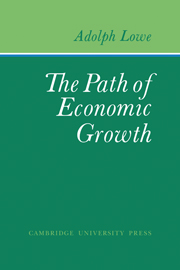Book contents
- Frontmatter
- Contents
- Preface
- Acknowledgments
- PART I The Basic Model
- PART II Changes in the Rate of Change
- 11 The Setting of the Problem
- 12 A Bird's-Eye View of an Expanding Traverse
- 13 On the Short-Period Variability of the Capital–Labor Ratio
- 14 Adjustment to a Higher Rate of Growth of Labor Supply in a Free Market. I. Structure Analysis
- 15 Adjustment to a Higher Rate of Growth of Labor Supply in a Free Market. II. Force Analysis
- 16 Adjustment to a Higher Rate of Growth of Labor Supply in a Collectivist System
- 17 Some Comments on the Role of Working Capital in the Traverse
- 18 Instrumental Analysis of Decline in the Rate of Growth of Labor Supply
- PART III Changes in the Rate of Change
- PART IV Changes in the Rate of Change
- Appendix: An Alternative Presentation of Lowe's Basic Model
- Glossary of Recurring Symbols
- Name Index
- Subject Index
18 - Instrumental Analysis of Decline in the Rate of Growth of Labor Supply
Published online by Cambridge University Press: 07 October 2011
- Frontmatter
- Contents
- Preface
- Acknowledgments
- PART I The Basic Model
- PART II Changes in the Rate of Change
- 11 The Setting of the Problem
- 12 A Bird's-Eye View of an Expanding Traverse
- 13 On the Short-Period Variability of the Capital–Labor Ratio
- 14 Adjustment to a Higher Rate of Growth of Labor Supply in a Free Market. I. Structure Analysis
- 15 Adjustment to a Higher Rate of Growth of Labor Supply in a Free Market. II. Force Analysis
- 16 Adjustment to a Higher Rate of Growth of Labor Supply in a Collectivist System
- 17 Some Comments on the Role of Working Capital in the Traverse
- 18 Instrumental Analysis of Decline in the Rate of Growth of Labor Supply
- PART III Changes in the Rate of Change
- PART IV Changes in the Rate of Change
- Appendix: An Alternative Presentation of Lowe's Basic Model
- Glossary of Recurring Symbols
- Name Index
- Subject Index
Summary
In defining the topic of this book and, in particular, the meaning we are going to attach to the notion of growth, we spoke of the formation, application, and liquidation of real capital. Up to this point we have dealt with growth only in the narrower sense of steady or unsteady expansion, and the problems we encountered there were exclusively related to the formation and application of fixed and working capital. Now the time has come for a closer look at the structural and motorial problems of capital liquidation, as posed by a fall in the rate of growth.
In a general way the issue has a long history, reaching back at least to Ricardo's concern with the approach of the system to a “stationary state.” However, apart from the effect on income distribution, one searches in vain for a detailed description of the path that is to lead to this terminal state, not to speak of the change in the intersectoral relations within industry, which such a process is bound to bring about. Although the secular fall in accumulation holds a strategic place in Marx's vision of capitalist development, the schemata of reproduction, his main theoretical tool from which our own structural analysis is derived, were used by him only for demonstrating processes of expansion.
After a lapse of decades, interest in the problem of decline was revived in the so-called maturity controversy during the thirties.
- Type
- Chapter
- Information
- The Path of Economic Growth , pp. 182 - 206Publisher: Cambridge University PressPrint publication year: 1976



